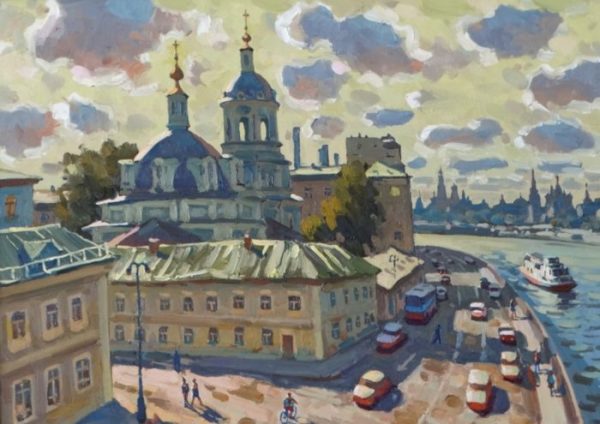He was a sea cook, a painter, a locksmith, and … a downright atheist. And then he came to an exhibition in Moscow, and his life turned upside down. Today, a famous artist Pavel Popov lives in the wilderness of the Northern Russia for days, helps restoring a rural church, participates in multi-day cross processions and reads Akathist hymns in a church every week…
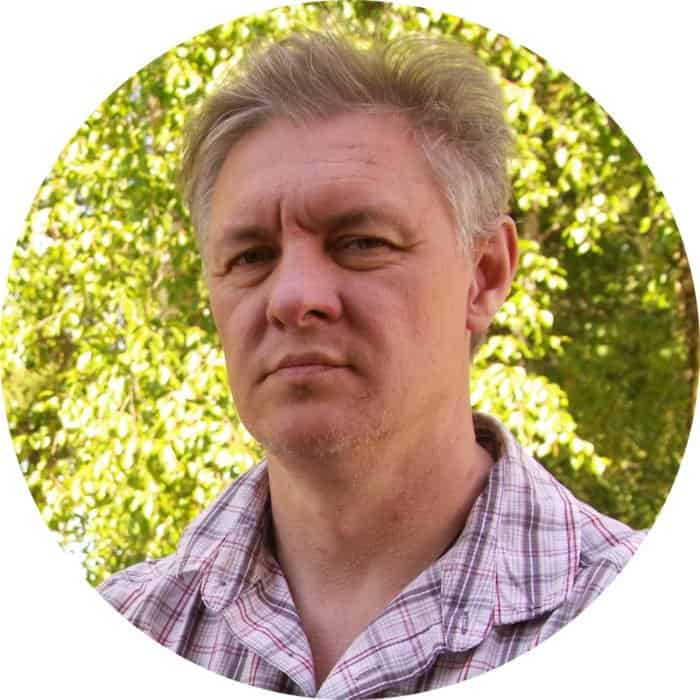
I Can Do It Too!
Neither in my childhood, nor in my youth did I study painting. I did not even hold a pencil in my hands. I lived in a small Ukrainian town of Izyum. What was life like there? The main meeting place was a bar…
I served in the Navy, managed to work as a sea cook and a house painter. When I was 24, I went to Moscow, got a job as a locksmith in AZLK. One time, in the early nineties when my girlfriend and I were walking around the city, we saw a huge poster for Glazunov’s exhibition. My girlfriend suggested, “Let’s go there!” The exhibition blew my mind. And I got a feeling: I can do it too!
Right after that I sat in front of my mirror in my dorm and drew a portrait of myself in a mink hat. Then two more pieces. And I came to Surikov Institute with them, “I want to enroll here!” Delicate professors looked at them and said, “Well, that’s a good start, but you have to practice for, like, five years”. I got really upset with them then! But then I saw freshmen’s pieces on the first floor of the institute and realized that it was not that simple…
I went to the factory cultural center and got a job as a watchman. They left me the keys, and all day long I read, drew, looked at the albums… And kept asking the teacher of an art studio, “Well, when will I become an artist?” And he said, “Make three thousand sketches first”.
“Three thousand? Piece of cake!” – I decided. I made one, then another… And then I did the math: three thousand sketches would take exactly five years of work.
The art studio closed down. Yet, I managed to get acquainted with Olga, my future wife. We had a boy. I continued practicing in different museums. Then the factory also shut down. I got a job as a doorkeeper and practiced and practiced…
Finally, my wife and I together went to Glazunov academy, brought my still-life and landscape paintings and sketches. We just came for an advice, instead I got an offer, “Enroll!” I did well at pictorial art and draftsman art, but I was a complete failure in composition – I did not study it earlier. However, I got a few extra points – they saw talent in me. I was already twenty seven, my son was three! I was the oldest in class…
An Atheist is a Person Who Has not Read the Scripture Much
I, an atheist, who used to laugh at the Church, enrolled at Glazunov academy, where everyone was a believer, a Christian. In the freshmen year we went on an excursion to the Trinity Lavra of St. Sergius. Everyone was crossing themselves and I thought, “Are they all crazy?”
Then they started giving us assignments. For example, a theme, “Joseph reveals himself to his brothers”. What is it? Who knows… I had to read. First the Old Testament, then the Gospel.
It turned out that an atheist is a person who simply has not read the Holy Scripture much. For when you open the Book of Psalms or a prayer book, you find that it is written differently from what atheists imagine. The fiftieth psalm, “Have mercy on me, O God, according to Thy great mercy; and according to the bounty of Thy mercies blot out my guilt” You read it and realize that you relate to that. I had also thought, “Why do envy, anger, and pride torment me? They do not let me go, they hurt me, do not let me communicate with other people…”
When I started reading the Gospel, I began to discover Christ for myself! And my soul began to reach out to Him. For there is Love!
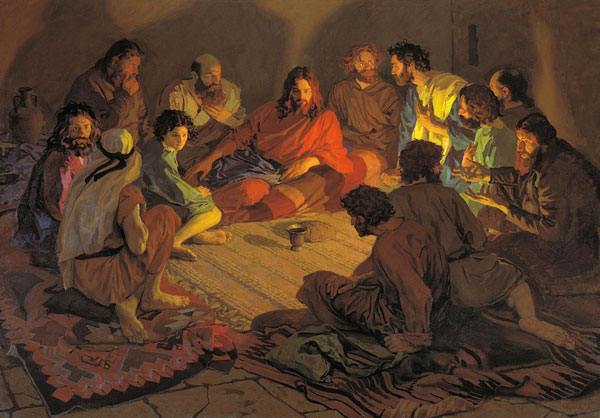
Last Supper, 2002
Everyone Drew “The Last Supper”
By my junior year the whole family – my son, wife and I – had been baptized. And then there was my thesis work – “The Last Supper”. I suffered for a long time, wanted to do “Ivan the Terrible” initially. Then I had a sudden daring thought, “Why don’t I paint “The Last Supper”?” Everyone drew this theme! But where to start, what to work with first?
And I began to read. I found out that there were no chairs in Christ’s time: the Apostles and the Savior reclined on the table. It was the first “key” to the composition. Then I had to dress my model in the corresponding clothes and lay them down – to see how the configuration would look like, for the language of a gesture is read as a word.
Then I drew the lantern, lit up the canvas and suddenly saw huge black shadows: all those at the table cast a shadow: the sign of trouble. The viewer looks at it and understands: something is coming…
They praised me for this painting. It was in Italy. Now it is at Glazunov Academy.
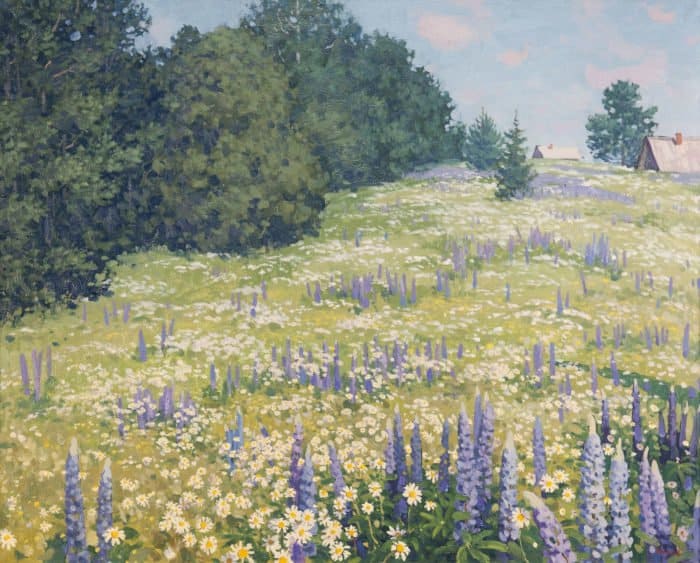
Chamomile field, 2011
Life in Shelota Village
After graduation I tried to work, I was a teacher. Once, an artist Mikhail Abakumov suggested to me that I should go to the Russian North, to Verkhovazhsky District of Vologda Oblast, to Shelota village. After all, I had not seen anything except the workshop at the institute. First we went there together, then I went there by myself. My wife and I bought a cabin, then a plot of land nearby, finally, we built a house there. What a view we have from our window! So many open spaces! So beautiful!
Here, in Shelota, we have a small Christian community. We gather in the evenings, drink tea together: it is cold in a church, especially in winter, so we meet in the village council building. In the church, with the blessing of a priest, we read Akathist Hymn to Saint Nicholas, Great Wonderworker. And once, we had an opportunity to take part in multi-day cross procession from Verkhovazhye to Totma: we walked for 130 kilometers through Totma tract. The cross procession was associated with the feast day of the Venerable Theodosius of Totma. It was the experience of a lifetime!
Every Sunday my wife and I ride to the district center, to Verkhovazhye – there we attend the Liturgy, partake of the Eucharist. In our village the Liturgy is held only during great feast days: our priest serves in several churches in our district, he needs to make it to each of them, but the roads here are not so good. The priest is young, he has a family, he gets tired…
People of Shelota treat religion in different ways. Few adult men go to the church. But we have good relations with the locals: they respect us, ask for our advice. One thing grieves me: the nature is magnificent here, but no one will buy a reproduction of Levitan painting, even though it is not expensive. Though at the same time an “awesome” painting of a tiger in a gold-plated frame for 600 rubles (approximately 10 dollars – Pravmir) sells like hot cakes. And to think that the splendid peasant culture of Vologda and Arkhangelsk, for example, existed before… Embroidery, ethnic weaving – it is fantastic! Alas, there is none of that in everyday life anymore. We visited Verkhovazhye museum, saw the remains of weaving looms. A sorry sight. Although employees of suburban museums are very passionate about artefacts, they even bring anything they can from home. They have enthusiasm in spades: they ask for reproductions of paintings, art albums are in great demand… People’s interest in the beautiful, in the great is huge, but, unfortunately, there are few sources and they are unavailable. There is no funding or support…
People are amazing here! They are real pearls! In Verkhovazhye and in Shelota we are friends, for example, with a sculptor, a potter, Tatiana Gorbatova, a specialist in Verkhovazhye painting handicraft style, Antonina Zavyalova, a wonderful graphic artist… They are local, they were born here and they live here… People do not reject culture, but aspire to it.
Here, in the North, people sometimes ask me, “Why do you draw sheds? Better draw a beautiful house! With siding”. But it was here that I became more sensitive to colors, their harmonic relationship.
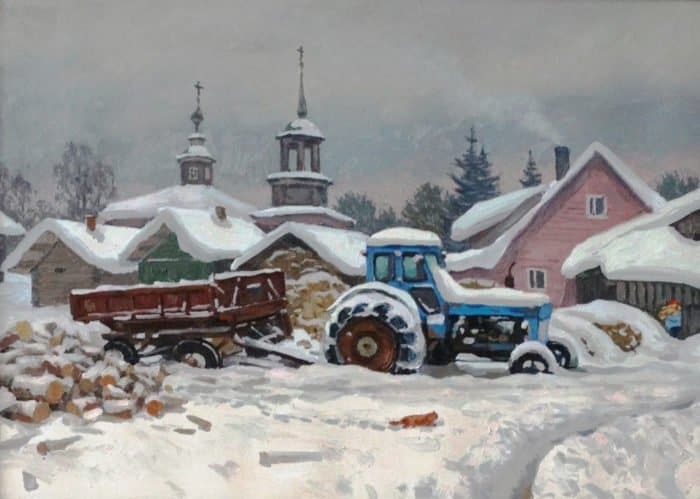
Village, 2017
Translated by Julia Frolova












